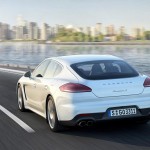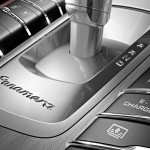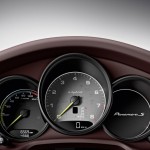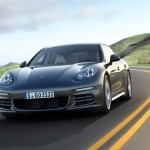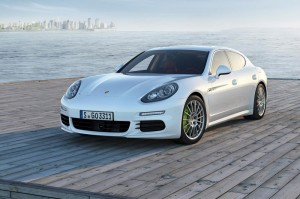
The new Porsche Panamera S-E Hybrid makes it’s debut at Goodwood Festival of Speed (FoS) today, 11th July 2013. With impressive performance figures and an equally wallet appealling fuel economy of 91.1mpg, the Porsche sets the pace in the world of hybrid sports cars.
- Second generation of Panamera Gran Turismo introduces plug-in hybrid technology to the executive segment for the first time – UK public debut in Goodwood Moving Motor Show pavilion
- Panamera S E-Hybrid offers 416 hp of combined power, with 95 hp electric motor and lithium-ion battery that can be recharged on the move or in four hours via appropriate domestic socket
- Fuel economy of up to 91 mpg on NEDC — 71g/km CO2 — with 0-62 mph in 5.5 seconds
- New twin-turbocharged 3.0-litre V6 engine joins the range
- Panamera range on sale now priced from £62,922, arriving in Porsche Centres from July
Since its launch in 2009, the Panamera Gran Turismo has successfully expanded the appeal of the Porsche marque into the executive saloon segment. Now, a new chapter in the development of the four door, four seater sports car opens with the unveiling of the second generation Panamera, led by the world’s first plug-in hybrid in the class.
The innovative Panamera S E-Hybrid offers combined system power of 416 hp and extends further the breadth of sportiness and comfort that characterises the model line. Furthermore, an entirely new twin-turbocharged 3.0-litre V6 is now offered in the Panamera S and Panamera 4S. These new and further developed drivetrain technologies have enabled fuel savings of up to 56 per cent, while further enhancing ease of use and driving comfort.
The new Panamera underscores its exceptional positioning with a more expressive exterior design language signified by tighter lines, more pronounced contours and newly-shaped body elements. Overall, the new generation car is more efficient, sporting, comfortable and elegant and celebrated its world premiere at Auto China in Shanghai on 21 April.
Panamera S E-Hybrid sets new standards in efficiency, performance and convenience
The Panamera S E-Hybrid is a systematically advanced development of the proven Porsche parallel full hybrid, with a more powerful electric motor, a higher-performance battery that supplies more energy and the ability to be recharged externally from the electrical grid.
The electric drive produces 95 hp (70 kW), which is more than double the power of the previous model’s 47 hp (34 kW) electric motor. It draws energy from a new lithium-ion battery, which at 9.4 kWh has over five times the 1.7 kWh energy capacity of the previous (nickel metal hydride) battery technology. When connected to an industrial outlet, it can be charged within around two and a half hours via the integrated on-board charger and the standard Porsche Universal Charger (AC), and it can be charged in less than four hours when connected to a conventional household electrical outlet.
With its increased output, the Panamera S E-Hybrid far exceeds the driving performance of the previous model. In addition, the NEDC fuel economy has increased by 56 per cent to 91 mpg, which equates to emissions of 71 g/km CO2. Furthermore, the all-electric driving performance has been substantially improved with regard to electric acceleration, the electric range and electric top speed.
An intensive pure electric driving experience is possible without any fuel consumption or local emissions, which is especially advantageous in the urban environment. The electric driving range of the Panamera S E-Hybrid has been determined as 22 miles (36 km) in NEDC-based testing. Driving range may vary in everyday operation, since air conditioning and heating are deactivated in NEDC test conditions, for example. A realistic all-electric driving range in everyday operation would lie somewhere between 11-22 miles – and under particularly favourable conditions it could even exceed this.
The Panamera S E-Hybrid can reach speeds of up to 84 mph in all-electric operation, and the acceleration time from 0-62 mph has been shortened by half a second to 5.5 seconds. The electric boost function helps here, in which the performance of the electric motor aids that of the combustion engine. Boosting can also be activated by kick-down – such as when overtaking. The car’s overall top speed is 168 mph. The parallel full hybrid concept developed by Porsche also offers ‘coasting’ at higher speeds, which refers to free coasting with the internal combustion engine shut off and generating electricity by energy recovery.
The forward-looking concept of the Panamera S E-Hybrid also embodies an entirely new range of convenience functions, which can also be activated and called up by a smart phone ‘app’. There is the charge status indicator, for example. In addition, the auxiliary climate control option of the plug-in hybrid enables car pre-heating or cooling via Porsche Car Connect; it can be programmed in the vehicle or even more conveniently via the smart phone app. A smart phone may also be used for battery management or for remote access to vehicle information such as the remaining driving range or for guiding users back to their parked vehicles. All functions that are not specific to the hybrid drive are also available as options for the other Panamera models via the Car Connect smart phone app from Porsche.
More performance and efficiency by downsizing: new twin-turbo V6 engine
Boosting performance and efficiency is a core competency at Porsche. In developing the new Panamera, this led to an entirely new engine based on the downsizing concept: a V6 engine with 3.0-litre displacement and twin turbocharging. The V6 bi-turbo replaces the previous 4.8-litre V8 engine in the Panamera S and Panamera 4S. Its basic parameters themselves are indicators of progress: 20 hp more power and a further 20 Newton metres of torque, combined with up to 18 per cent better fuel economy compared with the V8. This not only gives the driver a more powerful and efficient engine; turbocharging results in the maximum torque of 520 Nm being available over a very broad range of engine speeds for a superior and uniform power curve, even at low revs.
The majority of Panamera models feature the seven-speed Porsche Doppelkupplung PDK dual-clutch transmission. The eight-speed Tiptronic S automatic is used in the Panamera Diesel and Panamera S E-Hybrid, which creates optimal conditions for further development of other efficiency functions. For example, the extended start-stop function now deactivates the engine earlier while coasting to a stop, which saves more fuel. With the exception of the Panamera GTS, models with PDK also offer a coasting function in which the clutches open in overrun, the engine idles, and the vehicle coasts freely. This function can significantly improve fuel economy, especially when travelling on the motorway.
Design development highlighted by a new option of LED headlights
The evolutionary exterior design of the new Panamera is at first identified by the tighter and more prominent line-work on the nose, particularly the larger air intakes and the distinctive transition to the headlights. In side profile, the new, more swept-back rear window creates an extended silhouette. When viewed from the rear, the new generation Panamera is primarily identified by its new tailgate, and the wider rear window visually emphasises the sporting character. The rear section itself has also been redesigned, including the wider spoiler, and it shows a tighter transition to the rear lights, similar to the headlight treatment at the front of the car.
The new Panamera models also offer many differentiating exterior characteristics. Further customisation is achieved by a variety of options, including new LED headlights, which give the Gran Turismo a very distinctive appearance. In addition, an extended line-up of optional assistance systems is available for safety and convenience. The adaptive cruise control system, for example, now actively intervenes in the braking process in hazardous situations, and camera-based traffic sign detection and lane departure warning offer greater convenience.
The new generation Porsche Panamera will arrive in Porsche Centres from July 2013, priced from £62,922 for the Diesel to £107,903 for the Turbo.
Standard equipment on all models includes Bi-Xenon headlights, multi-function steering wheel, automatic tailgate opening, leather interior, dual-zone automatic climate control, front and rear parking sensors, cruise control, Porsche Communication Management satellite navigation with seven-inch touch-screen, Digital radio, eight-way powered front seat adjustment, heated front seats, floor mats and a three-year warranty. Four-wheel drive models add Porsche Traction Management (PTM) all-wheel drive.
Fitted to every Panamera is a Porsche Vehicle Tracking System (VTS), a sophisticated vehicle security package approved to Thatcham Category 5 standard. Customers will also be able to explore the potential of their new car, and further develop their own skills behind the wheel, by participating in a complimentary course at the Porsche Experience Centre, Silverstone.
Second generation Panamera: UK price and powertrain overview
| Power (hp/revs) |
Torque (Nm/revs) |
0-62mph | Top speed | NEDC economy | CO2 g/km | Price | |
| Diesel Tiptronic | 250 @ 3,800 | 550 @ 1,750 | 6.8s | 151 | 44.8mpg | 166 | £62,922 |
| V6 PDK | 310 @ 6,200 | 400 @ 3,750 | 6.3s | 160 | 33.6mpg | 196 | £63,893 |
| 4 V6 PDK | 310 @ 6,200 | 400 @ 3,750 | 6.1s | 159 | 32.5mpg | 203 | £67,454 |
| S V6 bi-turbo PDK | 420 @ 6,000 | 520 @ 1,750 | 5.1s | 178 | 32.5mpg | 204 | £82,079 |
| 4S V6 bi-turbo PDK | 420 @ 6,000 | 520 @ 1,750 | 4.8s | 177 | 31.7mpg | 208 | £85,721 |
| S E-Hybrid Tiptronic | 416 @ 5,500 | 590 @ 1,250 | 5.5s | 167 | 91.1mpg | 71 | £88,967 |
| GTS 4.8-litre V8 PDK | 440 @ 6,700 | 520 @ 3,500 | 4.4s | 178 | 26.4mpg | 249 | £93,175 |
| Turbo 4.8-litre V8 twin-turbo PDK | 520 @ 6,000 | 700 @ 2,250 | 4.1s | 189 | 27.7mpg | 239 | £107,903 |
Source; Porsche Press Release
